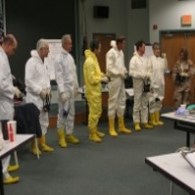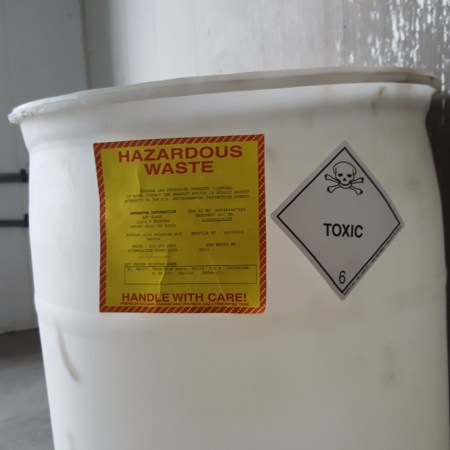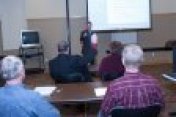RCRA Training
Do you have questions about Hazardous Waste Personnel training?… I can help.
If you generate any hazardous waste it is likely you and your employees require some form of annual Hazardous Waste Personnel training (aka: RCRA training). Even if you are not subject to full Federal and state regulations, I am confident you and your company will benefit from my training. Read on to learn about the regulations for RCRA Training and how they apply to you.
Don’t have time? Check out my concise summary of Hazardous Waste Personnel Training.
If you don’t see an answer to your question here, check out my FAQs at the bottom of this page.

Why is RCRA training required?
The generation, storage, transportation, and disposal of all waste – particularly hazardous waste – poses a threat to the environment and to the people (that’s us!) that rely on it. Since 1976 and the passage of the Resource Conservation and Recovery Act (RCRA), the U.S. Environmental Protection Agency and states with an authorized hazardous waste program have required training for companies that generate hazardous waste and their employees (i.e. Hazardous Waste Personnel). The purpose of this training is to ensure that Hazardous Waste Personnel understand the importance of the regulations and how to comply with them.
Who is required to receive RCRA training?
Initial and annual training is required for all personnel whose job responsibilities bring them into contact with hazardous waste, have a responsibility for management of hazardous waste, or may respond to a hazardous waste emergency. Personnel to be trained are sometimes referred to as Hazardous Waste Personnel, Facility Personnel, or RCRA Employees. Whatever the name, anyone who has anything to do with hazardous waste at a large quantity generator of hazardous waste (LQG) must receive some form of this training. This includes those who review or sign a uniform hazardous waste manifest.

Not sure of your hazardous waste generator status? Take this short survey.
What must RCRA training include?
The EPA regulations mandate that RCRA training include the following:
- Train personnel to perform their duties in compliance with the regulations.
- Teach personnel the hazardous waste management procedures specific to your facility including implementation of the contingency plan.
- “At a minimum” training must ensure personnel can respond effectively to hazardous waste emergencies at your facility.
Not content to just meet the minimum requirements, my RCRA training will include the following:
- Overview of the regulatory agencies and the regulations.
- Importance of facility’s “cradle-to-grave” responsibility for all waste it generates.
- Identification of a hazardous waste. And, universal waste, used oil, non-hazardous waste, state-specific wastes (if applicable).
- Regulatory exclusions from regulation (if applicable) and the conditions of the exclusion.
- On-site management of universal waste, used oil, non-hazardous waste, and state-specific wastes (if applicable).
- More site specific information as you require and as time allows.v

When must I train my hazardous waste personnel?
Hazardous Waste Personnel of an LQG must receive initial training within six months of employment or assuming a new job function that is applicable to the regulations. They must be directly supervised by trained and knowledgeable personnel if they perform a regulated function before receiving initial training.
Hazardous Waste Personnel of an LQG must also be provided with an annual review of the initial training. This must be conducted within one year of the initial training.
An SQG is not required to provide training for its Hazardous Waste Personnel at a specified frequency.
How do I ensure my RCRA training meets both Federal (USEPA) and state requirements?

First of all, ensure your training provider has received RCRA training or its equivalent within the last year. While no certification is required to provide RCRA training, the regulations require that your training program be directed by a person who has been trained. But anyone can sit through training once a year. You want a training provider who is knowledgeable about the regulations and can deliver that knowledge in an interesting manner. Check out my testimonials to see what your peers thought about my training.
Also, discuss the regulations and your training needs with the training provider until you are comfortable that they have the knowledge and the skills necessary. To help you with this, I wrote: Nine Questions to ask your RCRA Training Provider
Before you contact me, feel free to read the articles I’ve written for my blog. A quick review will show that I am not satisfied to simply comply with the regulations but instead dig deep to truly understand them.
I have 25+ years experience with the applicable regulations as a truck driver, Hazardous Waste Technician, consultant, and training provider. I have spent a lot of that time researching the RCRA regulations and assisting companies like yours to comply with them. My resume.
Where can I get more information about the EPA & State hazardous waste regulations?
- The National Center for Manufacturing Sciences (NCMS) operates EnvCap.org which contains helpful regulatory information for the states.
- I use my blog and other social media to share what I’ve learned about the regulations regarding HazMat transportation and the generation, handling, and disposal of hazardous waste.
- Ask me a question!
Frequently asked questions about hazardous waste:
What is RCRA?
The Resource Conservation and Recovery Act, passed by Congress in 1976 is the source of hazardous waste regulations codified in Section 40 of the Code of Federal Regulations (CFR) parts 260-279. Read more about RCRA.
Where is the regulatory citation that requires this training?
For a large quantity generator of hazardous waste (LQG), Personnel training is codified at 40 CFR 262.17(a)(7). The responsibility of a small quantity generator of hazardous waste (SQG) to ensure their employees are thoroughly familiar with how to handle hazardous waste and how to respond in an emergency is codified at 40 CFR 262.16(b)(9)(iii).
If your state refers to the Federal regulations for training it may still refer to their location in the CFR prior to the Generator Improvements Rule went into effect on May 30, 2017. If so, the citations will be 40 CFR 262.34(a)(4) and §265.16 for an LQG and 40 CFR 262.34(d)(5)(iii) for an SQG.
What is the intent of the training requirement?
The intent is to prevent improper disposal of a waste – particularly a hazardous waste – that might threaten human health or the environment. This is done through training. All Hazardous Waste Personnel, whether LQG, SQG, or CESQG/VSQG should be thoroughly familiar with how to manage hazardous waste on-site and necessary response in the event of an emergency.
Is training required for a small quantity generator (SQG) of hazardous waste?
SQGs are not subject to the same training requirements of an LQG at 40 CFR 262.17(a)(7), formerly §262.34(a)(4) and §265.16. However, per 40 CFR 262.16(b)(9)(iii), formerly §262.34(d)(5)(iii), an SQG is required to “ensure that all employees are thoroughly familiar with proper waste handling and emergency procedures relevant to their responsibilities”. While training – initial, annual, or other – is not specified, it is a good way to meet this requirement and stay in compliance. Read: RCRA Training for a Small Quantity Generator of Hazardous Waste.
Who must receive the training required at 40 CFR 265.16?
This regulation applies solely to facility personnel of a hazardous waste treatment storage and disposal facility (TSDF). However, under previous EPA regulations, it was referred to by 40 CFR 262.34(a)(4) as a responsibility of an LQG as well. Changes to the regulations under the Generator Improvements Rule now have the LQG training requirement contained entirely at 40 CFR 262.17(a)(7). The scope of the training requirement, however, hasn’t changed. It still applies to persons working for an employer of LQG status who handle hazardous waste as part of their job. It may include part-time or temporary workers, contractors, consultants, and off-site managers. The employer may be a business, government agency, or school.
Who are “Facility Personnel”?
40 CFR 262.17(a)(7), formerly §265.16, refers only to “facility personnel”, by consensus within the industry employees who require this training are referred to variously as: “Hazardous Waste Personnel” or “RCRA Personnel”. Thus, the training is sometimes referred to by different titles: “RCRA Training”, “EPA Hazardous Waste Training”, “Hazardous Waste Personnel Training”, etc. While the name may be confusing, the Federal regulations are not. 40 CFR 262.17(a)(7) requires annual training of all facility personnel of a Large Quantity Generator of hazardous waste whose job brings them into contact with hazardous waste or a hazardous waste emergency. Small Quantity Generators have a training requirement as well. Hazardous waste in satellite accumulation areas are not subject to the training requirement.
What is a large quantity generator of hazardous waste?
An LQG may be a commercial, industrial, or government facility that generates ≥1,000 kg (2,200 lbs) of hazardous waste in any calendar month or >1 kg of acute hazardous waste or >100 kg of acute hazardous waste spill residue in any calendar month. A large quantity generator is defined at 40 CFR 260.10 as follows:
Large quantity generator is a generator who generates any of the following amounts in a calendar month:
- Greater than or equal to 1,000 kilograms (2200 lbs) of non-acute hazardous waste; or
- Greater than 1 kilogram (2.2 lbs) of acute hazardous waste listed in §261.31 or §261.33(e) of this chapter; or
- Greater than 100 kilograms (220 lbs) of any residue or contaminated soil, water, or other debris resulting from the cleanup of a spill, into or on any land or water, of any acute hazardous waste listed in §261.31 or §261.33(e) of this chapter.
What is a small quantity generator of hazardous waste?
An SQG may be a commercial, industrial, or government facility that generates ≥100 kg (220 lbs) but <1,000 kg (2,200 lbs) of hazardous waste in any calendar month. An SQG must also generate ≤1 kg (2.2 lbs) of acute hazardous waste and ≤100 kg of acute hazardous waste spill residue in any calendar month. A small quantity generator is defined at 40 CFR 260.10 as follows:
Small quantity generator is a generator who generates the following amounts in a calendar month:
- Greater than 100 kilograms (220 lbs) but less than 1,000 kilograms (2200 lbs) of non-acute hazardous waste; and
- Less than or equal to 1 kilogram (2.2 lbs) of acute hazardous waste listed in §261.31 or §261.33(e) of this chapter; and
- Less than or equal to 100 kilograms (220 lbs) of any residue or contaminated soil, water, or other debris resulting from the cleanup of a spill, into or on any land or water, of any acute hazardous waste listed in §261.31 or §261.33(e) of this chapter.
Who is responsible to ensure that applicable personnel – including on-site contractors – receive Hazardous Waste Personnel training?
The person (i.e business owner or government agency) that is responsible for generating the waste must ensure applicable personnel have been trained in compliance with the regulations.
How frequently must Hazardous Waste Personnel be trained?
Applicable personnel must be trained within six (6) months of new employment or new job responsibility. Hazardous Waste Personnel must be supervised by trained and knowledgeable personnel prior to receiving initial training. A review of the initial training must be conducted annually (read: Annual Review of Initial Training for LQGs). Training must be documented and a record kept for at least three years for the end of the trainees employment (read: Documenting RCRA Training for Hazardous Waste Personnel).
What must the training include?
The scope and type of training is not defined. However, in broad terms, the training must ensure that all personnel at the facility are able to do the following:
- Perform their duties in compliance with the regulations.
- Conduct site-specific job responsibilities.
- Effectively respond to a hazardous waste emergency situation and are familiar with emergency procedures, emergency equipment, and emergency systems.
Who can conduct the training?
The training program must be directed by someone trained in hazardous waste management. This means they must have received initial training with the annual review. More than this though, your instructor must have a thorough knowledge of the regulations and know how to deliver it to those who don’t in an engaging manner. Those providing classroom-type training should be experts in the field of hazardous waste management to ensure questions that come up during training are answered correctly.
What topics are covered in the RCRA Personnel training provided by Daniels Training Services?
My training will vary depending upon the needs of the customer. However, both site-specific training and my public training will include the following to varying degrees:
- Introduction to the regulatory agencies and the USEPA
- Introduction to RCRA
- RCRA’s training requirements
- An explanation of the process of waste determination
- Identification of wastes generated at a facility
- Description of hazardous waste generator status
- Reporting requirements
- Hazardous Waste Contingency Plan
- On-site waste storage and handling
- Weekly inspections
- On-site hazardous waste treatment options
- RCRA air emission standards
- Used oil management
- Universal waste types and management
- Preparation for off-site shipments of hazardous waste
- Treatment Storage and Disposal Facilities (TSDF’s)
- Recycling & Pollution Prevention
- Handling and disposal of miscellaneous wastestreams
- Preparing for Agency inspections
Can the OSHA emergency response training fulfill all my RCRA training requirements?
Training used to fulfill OSHA’s regulatory requirements of 29 CFR 1910.102(p)(8) and 1910.120(q) will fulfill the emergency response training requirements for RCRA Personnel. This applies to the emergency response portion of the training only. It does not address all the training requirements for Hazardous Waste Personnel.
